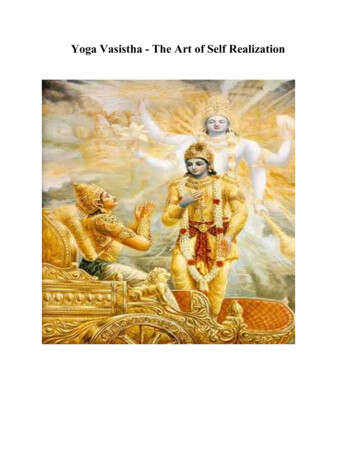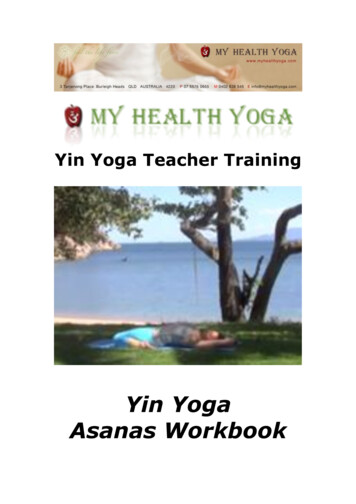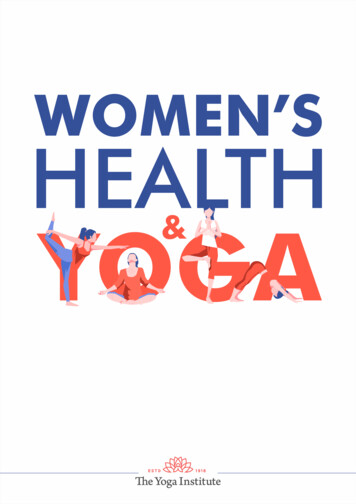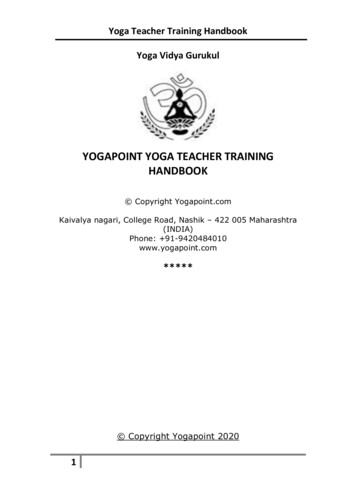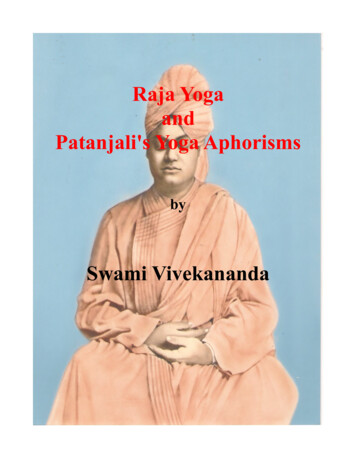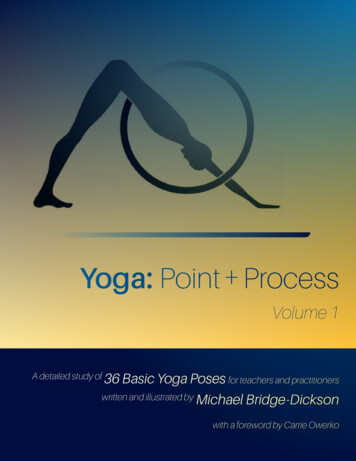
Transcription
Yoga: Point ProcessVolume 1A detailed study of 36 Basic Yoga Poses for teachers and practitionerswritten and illustrated by Michael Bridge -Dicksonwith a foreword by Carrie Owerko
The Yoga Process, Point by Pointāsana that makes senseYoga: Point Process is a comprehensive technical manual that details 36 of yoga’s mostfundamental poses.It is an excellent study aid for teachers and teachers in training, as well as being a useful toolfor every yogāsana student at any level of experience, whether new to yoga or a seasonedpractitioner.This unique and practical resource supports learning, practicing, and teaching āsanawith precision and detail, providing clear and concise instructions systematically guidepractitioners through each pose’s four stages, point-by-point — a process that supports thestudy and integration of fundamental principles while gradually learning their finer details,from when to learn them to managing challenges as they arise, and complete step-by-steppractice instructions that take practitioners through preparation, entering and exiting the posesafely, and what to do while in the poses themselves.Available on Amazon
Praise for Yoga: Point Procesāsana that makes sense“The whole book is filled with intelligence and elegance.Michael has provided the type of practice explorations that will inspire students to lookaround their homes and apartments for inspiration and possibility, and begin to use what isreadily available in their environment to make their practice more accessible, effective, andeven therapeutic.Yoga: Point Process is a unique and wonderful contribution to the diversity of yogabooks available.” Carrie Owerko, senior Iyengar Yoga Teacher and contributor at Yoga Journal“Michael Bridge-Dickson’s Yoga: Point Process is a dream come true for all yogateachers and teacher trainees eager to dive into the nuances of yoga alignment.Michael’s refusal to believe there’s only one way to do a pose is refreshing; his use ofprops creative; and the exhaustive array of choices he provides for even the simplestposes will be a joy to explore in my own body and pass along to my students.” Linda Sparrowe, former editor-in-chief of Yoga International and author, most recently,of Yoga At Home“There is always more to learn about yoga postural practices, and in Yoga: Point Process, Michael Bridge-Dickson has given us a true gem.His insightful understanding of the nuances of asana is a boon to students and teachersalike. I highly recommend it, especially for new and experienced yoga teachers.” Mark Stephens, author of Yoga Therapy: Foundations, Methods and Practices forCommon Ailments
Praise for Yoga: Point Procesāsana that makes sense“Occasionally a yoga book comes my way that makes me think, ‘Gee, I wish I’d written thisone.’ Michael Bridge-Dickson’s Yoga: Point Process is definitely one of them.I like so many things about it I don’t even know where to begin. What impressed me themost, and what makes this book so unique, is that it treats asana as a process, not a state,with equal emphasis on the beginning, middle, and end of the pose.This I’m sure will make the exercises much more effective and far less injury-prone.Experienced teacher or raw yoga rookie, no matter, this book’s for you.” Richard Rosen, contributing editor at Yoga Journal, and author of The Yoga of Breath,Pranayama: Beyond the Fundamentals, Original Yoga, and Yoga FAQ“Yoga: Point Process is an invaluable resource for all postural Yoga practitioners.Michael’s superb book is clearly written and insightful, and is sure to guide many to adeeper level of practice.” Brenda Feuerstein, Director of Traditional Yoga Studies and author of The Yoga-SutrasFrom a Woman’s Perspective and co-author of The Matrix of Yoga and The BhagavadGita: A Translation with Georg Feuerstein, Ph.D.
Four Layers of Understandingāsana that makes senseWhen we learn anything new or seek to deepen our understanding, it is always useful to doso in layers, each one built upon the last. Each pose in Yoga: Point Process is presented infour such layers: simplify reduces the pose to its most rudimentary formexplore develops the pose, increasing resilience and agilitynourish deepens your understanding by resting in awarenesssynthesize blends sensitivity and inner intelligence with refinementsIn this book, not only will you learn each pose in progressivelayers, you will also find useful suggestions on how to solvethe various challenges you may encounter along the way.Yoga: Point Process will serve as an invaluable support toyour practice, a resource that you can refer to time and again.Practitioners will find a variety of ways to work with classicalposes, exploring the finer details while developing a selfguided practice.Yoga teachers will particularly benefit from the systematicapproach to layering pose variations, supplementingteacher training and development programs, continuingas a sustaining referencethroughout your teachingcareer.Hundreds of detailed illustrations accompany and clarify thetext, making Yoga: Point Process a joy to use.The book also includes a guide to the book’s layout andsuggestions on how to use the book, along with generalpractice guidelines on how to structure a practice and whattypes of poses to do and/or avoid for common concerns.The back of the book features an in-depth terms definitionssection that is much more than a glossary, and is alone worthstudying. Front to back, Yoga: Point Process is packedwith information!
Publication Infoāsana that makes senseTitle: Yoga: Point Process Volume 1Subtitle:A detailed study of 36 Basic Yoga Poses for teachers and practitionersAuthor: Michael Bridge-DicksonIllustrator:Michael Bridge-DicksonPublisher:sensāsanaRelease Date:November 25, 2017Price: 39.95 USD 49.95 CANISBN: 978-1-7751054-0-4Specs:348 pages8.5” x 11”SoftcoverColor printingText ndigo.cabarnesandnoble.comYour local retailersComplete review copies will be available prior to the launch date, and samples are availablefor review immediately.Please inquire for review or sample copies as well as distribution: yoga@sensasana.comOrder directly: sensasana.com/point-process/
Author, Illustrator, Teacherāsana that makes senseMichael Bridge-Dickson has been guidingpractitioners on their inner journeys since2004. He has worked with athletes, dancers,seniors, people with reduced mobility, thosewith special concerns, as well as regular,everyday practitioners of all ages, abilities, andbackgrounds.Michael’s passion is helping peopleunderstand themselves — observing theirpatterns and habits, the mind revealing itselfthrough the body.As a teacher, Michael uses his keen eye fordetail and vision of how those details affectthe overall practice over time to structuresequences that help practitioners navigatethrough their yoga path.Articulate and communicative, Michael strives to reach as many practitioners as possible,showing them how they can benefit from yoga’s gifts safely and effectively while findingpersonal and physical fulfillment.His vision stretches beyond those Michael connects with in classes, inspiring him todelve into writing to share useful information that can reach all who would benefit from hisapproach.Michael combines his skills as a writer and illustrator to bring you his experience in a way thatis clear and accessible so that you get the most out of your practice while integrating andapplying helpful principles.For all media inquiries, to book Michael for interviews, speaking teaching engagements, orto discuss how yoga can benefit you and your organization, please contact:Michael 514) 717-0555
Here to Respond to your Inquiriesāsana that makes senseMichael’s students and colleagues often describe him as a “walking encyclopedia” of yogicknowledge — you can ask him virtually anything pertaining to yoga (or not!) and he will likelyhave a deep and intelligent answer.Some interviewers may not necessarily be involved in yoga, or know what aspects of yogaand yoga practice will be most relevant.In preparation for the release of his new book, Yoga: Point Process, below is a sampleinterview that targets the book, but also gives more background on Michael, yoga, andhis perspective on practice. When booking Michael for interviews, please let him knowthe planned duration of the interview, and whether the interviewer prefers more elaborateanswers to fewer questions, or shorter answers so that the interviewer can cover more ground— or when time is limited, few questions and short answers! Again, these are just examples,and Michael invites interviewers to ask any pertinent questions they wish.With so many books on yoga currentlyavailable, what prompted you to write thisbook?I wanted to create a resource that wasaccessible to both yoga teachers and seriousyoga students. Often, dedicated practitionersenroll in teacher training programs notbecause they want to teach, but because theyhope to deepen their understanding of thepractice in a way that classes and many booksdo not delve into.I also witness a lot of teaching that couldbe much more refined — clearer instructionabout how to enter or exit a pose, moreguidance on what to observe while there, andmost importantly: how to address commonchallenges practitioners may face in theseposes.
Here to Respond to your Inquiriesāsana that makes senseWhy are all these details so important — Isn’t it enough just to do the poses?No, I don’t believe it is. How the poses are done is, in my opinion, even more importantthan which poses are practiced. This includes how the poses are entered and exited: whenpractitioners are injured in yoga, it is often how they went into or came out of a pose thatcaused the most significant damage, not the pose itself — although there are of course posesthat are not appropriate for all practitioners and may be riskier to practice than others.Not only that, but many poses are simply not accessible to certain practitioners, even at thebeginner level. This is where the various layers and variations of poses become relevant. I dobelieve that most basic poses are suitable for everyone, but they may need to practice morefundamental related poses first, or find a variation that bridges their current capacity and theclassical form.From what I observe, beginner classes are not always truly “beginner” — they will oftenstart with the full form of a basic classical pose, but without understanding how to teach thefundamental mechanics, and these mechanics are often better learned in regressions of theposes. Once learned, they are more easily applied to the classical forms, rather than having tostruggle applying those principles in poses where the structure is more complicated.
Here to Respond to your Inquiriesāsana that makes senseDo you feel that a book can teach yoga poses effectively?Not completely, no. Nothing replaces a good teacher, and no external resource, even a greatteacher, can replace personal experience. Yoga: Point Process is intended to supplementpractitioners’ existing modes of study, whether that is attending group classes, studyingprivately with a teacher, or doing a self-guided practice.This book is a study aid, and I have many more tools resources planned to help practitionersdevelop and deepen their practice. I also hope it will help keep them safer, as a particular areaof interest for me is preventing yoga injury and managing other injuries through yoga.I also hope that yoga students and teachers alike will read this book to raise their level ofunderstanding, so that we can continue to practice with ever increasing sophistication.What makes your book stand apart?Three things: it’s (I hope!) easy to understand and apply it’s fairly comprehensive in addressing common needs the depth of information is not always found in other yoga booksOh, and it’s beautiful!You not only wrote this book, but you also did the layout and illustrations, is thatcorrect?Yes, I have always been very artistic and loved drawing all my life. I also have a backgroundin fashion design and illustration, so it only made sense to utilize those skills on this project. Iwanted to produce a book that was both beautiful and useful, because we’re naturally moreinclined to use things that appeal to our senses, and that includes how-to books!You say you’re particularly interested in yoga and injury. Is this a common problemamong yoga practitioners?It is. There are many reasons for this, and part of it is just that the more people who engage inany type of physical activity, the more there will be individuals who get injured. But, I also thinkthat the lack of refinement in some instructions, and the speed with which aspiring teacherscan become teachers creates a learning environment where even the teacher may not befully aware of the potential risks. When combined with any tendency to achieve or overdo orimpress people with our proficiency in yoga, injuries are a likely result.
Here to Respond to your Inquiriesāsana that makes senseInjuries are not entirely attributable to yoga, teachers, or students, but acknowledging andaddressing the risks fairly from all sides will help minimize the prevalence of yoga injuries —and may even help people recover from other injuries, too!You’re releasing a second book to deal specifically with injury very soon, correct?Yes, that’s correct! Shortly after Yoga: Point Process is launched, I will be releasing mysecond upcoming book, Pain in the Asana, in which I discuss several ways to care for 8common yoga injuries: what to do and what to avoid, how to modify for particular injuries, andhow to minimize the risk of injury in the first place.Any take-away tips from that book you’d like to share before its release?I would say that the most important aspect is moderation — to not push in your yoga practice— activate the muscles and work well, but don’t stretch beyond your capacity and don’t fightagainst yourself. Additionally, it’s always good to check with your primary care physician toensure yoga is appropriate for you, and then do some research on teachers and studios inyour area to find skilled and knowledgeable teachers.Teachers are not always to blame for yoga injuries, but poor instruction is a leading causeof injury. Lastly, it’s important to understand that not all intense sensation is bad, and lackof sensation doesn’t necessarily mean nothing’s happening: when you experience intensesensation in yoga, gently back off of the pose until the sensation is more tolerable. If that’s notpossible, come out of the pose, but try not to do so suddenly or aggressively — many yogainjuries happen when coming out of poses carelessly.What’s coming up for you, do you have any more projects on the go?I do, yes. In addition to Pain in the Asana, I’m releasing another book on Restorative Yoga inthe next year, and I have a few more secret projects that will support people in their personalstudy of yoga. {Additional, timely projects and events will be announced here}Where do you currently teach, and how can people contact you?I currently teach at Naada Yoga Montreal and offer workshops trainings at Ashtanga YogaMontreal. I’m also available for private lessons, guest teaching, speaking engagements, andother learning opportunities.
Here to Respond to your Inquiriesāsana that makes sensePeople can visit my website at www.sensasana.com to learn more about me and what I offer.All of my social media links are on the site too, so people can follow and contact me fromthere.Do you have any special offers for our viewers/readers today?Yes! {Michael will determine a special offer, based on current workshop offerings, publications,and the media outlet’s suggestion}Is there a particular charity you support?Yes! I’m currently involved with the Yoga Mala Foundation, which helps fund yoga programsfor non-profit organizations, providing access to yoga for those who would not normally haveaccess to yoga — and often those who don’t have access to yoga are those who would mostbenefit from it. I’m honoured to be one of the wonderful teachers involved in the Yoga MalaFoundation, and I’ve seen it affect people’s lives in the most touching ways. Currently, theYMF operates within Montreal, but it is planning to branch out across Canada to provide thesame great service to all Canadians who would benefit from a yoga practice.I’m also involved with an organization called Love Your Brain, which teaches people how touse yoga as a treatment supplement for traumatic brain injury.Some additional sample questions might include: Where should people start their journey toward a yoga practice?What are the benefits of starting a yoga practice?Can yoga be practiced with specific health concerns? Does yoga help?How can people reduce their risk of injury in yoga?Where can people purchase the book, once it’s available?How did you come to yoga, and what made you decide to become a teacher?Ask away, Michael is an open book!Order Yoga: Point Process today!
A detailed study of 36 Basic Yoga Poses for teachers and practitioners written and illustrated by Michael Bridge -Dickson with a foreword by Carrie Owerko. sana that akes sense The Yoga Process, Point by Point Yoga: Point Process is a comprehensive technic






